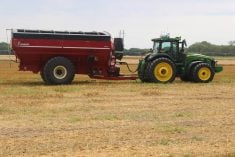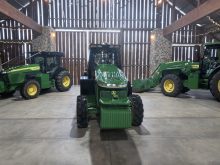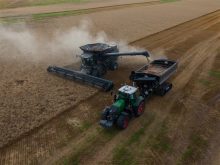Company will remotely monitor autonomous tractor activities as they perform a growing list of agricultural jobs
Tech start-up company Sabanto appeared on the agricultural scene not all that long ago with its autonomous conversion kit for regular ag tractors.
Early in the company’s evolution, the model-specific kits were limited to just Kubota M5s and some John Deere 5000 Series models. However, that list of compatible tractors has grown significantly.
“We have 19 tractor models, Deere, Kubota and Fendt,” says Craig Rupp, chief executive officer and founder of Sabanto.
Read Also

Defence investments could benefit agriculture
A bump in Canada’s NATO spending commitments could lead to infrastructure investments that would benefit rural areas
“We’ll continue to expand that.”
Which models get added to the list of compatible machines in the future will depend on whether they are likely to be popular with growers or other customers looking to add an autonomous machine to their operation.
“When we come across an opportunity, we ask, is this a model we should support?” he adds.
“Right now, we can add any tractor model to our platform in 90 days.”
As the model range expands, so has the level of service Sabanto is willing to provide its customers.
“The newest thing is we have what we call virtual field operators,” he says.
“These are our people that are an extension of some of the farming operations we’re working with.”
Rupp says farmers can monitor the tractor themselves if they want, but his company has found that many of its customers are too busy to respond to a notification from an autonomous tractor in a timely fashion. So the company will now handle that on behalf of a grower as well as manage its operation on a subscription basis.
However, if someone needs to actually go out to the field and manually do something, that will still be the farmer’s responsibility, which should be a rare occasion, Rupp says.
All the customer has to do is inform the virtual field operator what fields and functions the tractor is required to work and leave it to Sabanto to handle things remotely from there on.
“The people at the farming operation park the tractor in a field. Her (the virtual field operator’s) responsibility is deploying the system, monitoring it, moving it from field to field. Right now, she watches over about 12 systems at once, and five farming operations.”
The tractors don’t need to be constantly watched as they work; they simply need someone to be able to respond to messages from it and arrange to get it to do what the farmer wants at the right time. That also means a farmer or farm manager can go home for the evening and be sure a tractor operating after the normal workday is over will still be monitored.
“In the markets we’re in now, we found when they leave the farm, they’re done for the day,” says Rupp.
“With the promise of 24/7 (operation), when they go home at night, they’re preoccupied. So I have people that are working with farming operations and performing those tasks.”
To help farmers decide if an autonomous tractor will fit into their operation, Sabanto has an M5 Kubota equipped with its system that farmers can try out on their operations.
“We like to just bring it out, put it on the farm and see how it works, show growers how to run it and see what they can do with it, if it fits their operation,” said Alex Valdez, Sabanto field application engineer, who was showing the tractor at Canada’s Outdoor Farm Show in Woodstock, Ont., in September.
Rupp believes the easiest and most practical way to add autonomy to a farming operation is to start with simple jobs that are fairly routine.
“I don’t think autonomy is an all or nothing proposition. There are certain operations that are still going to have to be done manually into the short and mid term.
“Right now I’m focused on reducing labour. My goal right now is to start with the mundane and work toward improving it and getting better and better. As a startup, we have to refine, improve and fix problems.
“Do I see a future where every kernel is harvested from a field, lands in the grain bin without any human interaction? That’s a good vision, but we’re talking 20 or 30 years from now.”
















